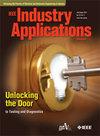IF 4.2
2区 工程技术
Q2 ENGINEERING, ELECTRICAL & ELECTRONIC
引用次数: 0
摘要
GaN HEMT 的短路耐受时间(SCWT)较低,这对其可靠性提出了挑战,尤其是在电动汽车充电器等中高功率应用中。本文根据电路中的状态变量和数据表参数,对包括寄生元件在内的 GaN HEMT 半桥配置中的短路故障瞬态进行建模。较高总线电压下的故障会导致瞬时功率损耗增加,进而导致结温升高。这导致器件的 SCWT 降低。该模型还可用于估算不同直流母线电压下的故障清除时间。介绍了 GaN HEMT 超快过流保护方案。该保护方案采用基于非侵入式 PCB-embedded Rogowski Coil (PCB-RC) 的电流感应技术来感应器件电流。实验结果表明,直流母线电压设置为 400 V 时,在发生硬开关故障 (HSF) 时可对器件进行保护。据报告,保护响应时间为 38 ns,小于估计的故障清除时间。本文章由计算机程序翻译,如有差异,请以英文原文为准。
Analytical Modeling of Fault Transient in a GaN HEMT Half Bridge and Its Overcurrent Protection With PCB Embedded Rogowski Coils
The low Short Circuit Withstand Time (SCWT) offered by GaN HEMTs imposes challenges on their reliability, especially in medium to high power applications such as electric vehicle chargers. This article models the short circuit fault transient in a GaN HEMT half-bridge configuration including parasitic elements, based on the state-variables in the circuit and the datasheet parameters. Faults at higher bus voltages result in increased instantaneous power loss, which in turn lead to higher junction temperatures. This results in reduced SCWT for the device. The model is further used to estimate the fault clearing time for different dc bus voltages. A scheme for ultrafast over-current protection of GaN HEMTs is presented. The protection scheme employs a non-intrusive PCB-embedded Rogowski Coil (PCB-RC) based current sensing technique for sensing the device current. Experimental results with the dc bus voltage set to 400 V, demonstrating the protection of the device subjected to a hard switched fault (HSF) are presented. The protection response time is reported to be 38 ns, which is less than the estimated fault clearing time.
求助全文
通过发布文献求助,成功后即可免费获取论文全文。
去求助
来源期刊

IEEE Transactions on Industry Applications
工程技术-工程:电子与电气
CiteScore
9.90
自引率
9.10%
发文量
747
审稿时长
3.3 months
期刊介绍:
The scope of the IEEE Transactions on Industry Applications includes all scope items of the IEEE Industry Applications Society, that is, the advancement of the theory and practice of electrical and electronic engineering in the development, design, manufacture, and application of electrical systems, apparatus, devices, and controls to the processes and equipment of industry and commerce; the promotion of safe, reliable, and economic installations; industry leadership in energy conservation and environmental, health, and safety issues; the creation of voluntary engineering standards and recommended practices; and the professional development of its membership.
 求助内容:
求助内容: 应助结果提醒方式:
应助结果提醒方式:


